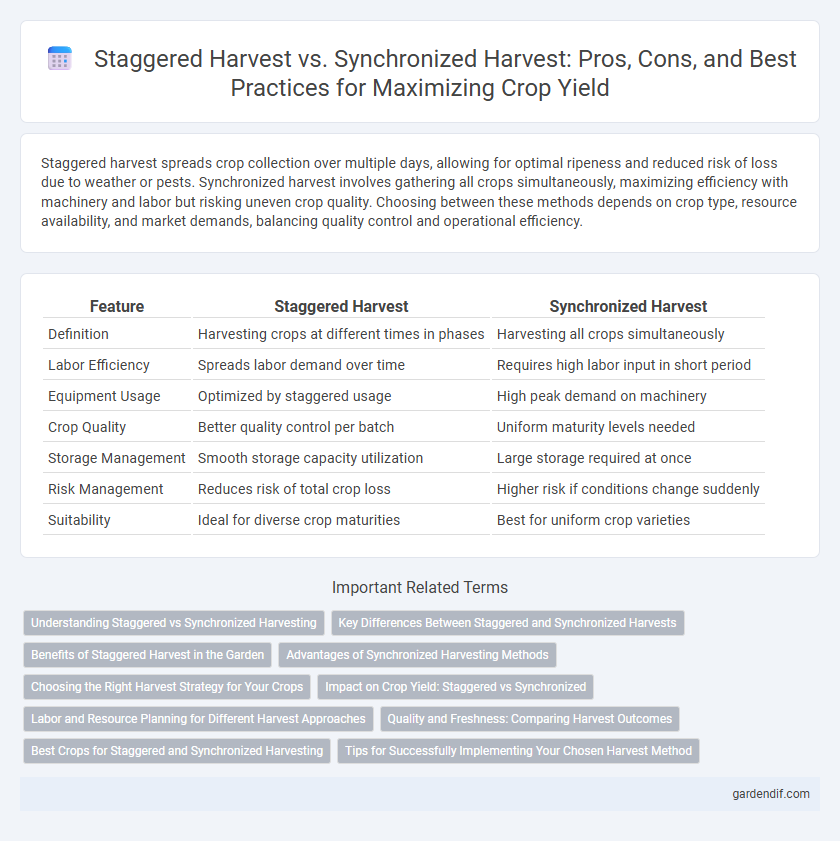
Staggered Harvest vs Synchronized Harvest Illustration
Staggered harvest spreads crop collection over multiple days, allowing for optimal ripeness and reduced risk of loss due to weather or pests. Synchronized harvest involves gathering all crops simultaneously, maximizing efficiency with machinery and labor but risking uneven crop quality. Choosing between these methods depends on crop type, resource availability, and market demands, balancing quality control and operational efficiency.
Table of Comparison
| Feature | Staggered Harvest | Synchronized Harvest |
|---|---|---|
| Definition | Harvesting crops at different times in phases | Harvesting all crops simultaneously |
| Labor Efficiency | Spreads labor demand over time | Requires high labor input in short period |
| Equipment Usage | Optimized by staggered usage | High peak demand on machinery |
| Crop Quality | Better quality control per batch | Uniform maturity levels needed |
| Storage Management | Smooth storage capacity utilization | Large storage required at once |
| Risk Management | Reduces risk of total crop loss | Higher risk if conditions change suddenly |
| Suitability | Ideal for diverse crop maturities | Best for uniform crop varieties |
Understanding Staggered vs Synchronized Harvesting
Staggered harvest involves collecting crops at multiple intervals, allowing for optimal ripeness and reduced risk of total crop loss, while synchronized harvest gathers all produce at once, maximizing efficiency and machinery use. Understanding staggered vs synchronized harvesting is essential for balancing quality, labor management, and market timing. Choosing the appropriate method depends on crop type, climate variability, and storage capabilities.
Key Differences Between Staggered and Synchronized Harvests
Staggered harvest involves collecting crops at multiple intervals, allowing for extended availability and better management of crop maturity variations. Synchronized harvest gathers all crops simultaneously, maximizing efficiency and reducing labor costs but requires uniform crop readiness. Key differences include timing flexibility, labor distribution, and post-harvest handling, with staggered harvests offering adaptability and synchronized harvests optimizing operational simplicity.
Benefits of Staggered Harvest in the Garden
Staggered harvest promotes a continuous supply of fresh produce by allowing crops to mature at different intervals, reducing waste and ensuring garden productivity over time. This method enhances pest and disease management by minimizing the spread through sequential harvesting rather than mass collection. Gardeners benefit from improved soil health as staggered harvesting encourages less soil disturbance and supports sustainable nutrient cycling.
Advantages of Synchronized Harvesting Methods
Synchronized harvesting methods enhance operational efficiency by allowing the entire crop to be collected at its peak maturity, resulting in uniform product quality and reduced post-harvest losses. This approach facilitates better resource allocation, including labor and machinery, minimizing downtime and optimizing logistics for transportation and storage. Improved timing also helps in managing market supply effectively, maximizing profitability through consistent and predictable yields.
Choosing the Right Harvest Strategy for Your Crops
Choosing the right harvest strategy depends on crop type, market demand, and weather conditions to maximize yield and quality. Staggered harvest allows for continuous picking, reducing losses and adapting to varying maturity rates, while synchronized harvest concentrates labor and equipment use for efficiency in uniform crops. Evaluating your specific crop growth patterns and logistical capabilities ensures optimal timing and resource allocation for a profitable harvest.
Impact on Crop Yield: Staggered vs Synchronized
Staggered harvest allows for optimized crop yield by enabling selective picking at peak ripeness, reducing losses due to overripe or underripe fruit. Synchronized harvest often leads to increased efficiency but may sacrifice overall yield quality, as crops are harvested simultaneously regardless of individual maturity levels. Studies show staggered harvest can improve total yield by up to 15% compared to synchronized methods.
Labor and Resource Planning for Different Harvest Approaches
Staggered harvest requires flexible labor scheduling and resource allocation spread over an extended period, allowing for continuous work but complicating workforce management and increasing logistical costs. Synchronized harvest concentrates labor and equipment deployment into a narrow timeframe, optimizing resource use but demanding large, temporary spikes in workforce and machinery availability. Efficient planning for both approaches must balance labor capacity, equipment readiness, and crop perishability to ensure maximum yield and cost-effectiveness.
Quality and Freshness: Comparing Harvest Outcomes
Staggered harvest improves produce quality by allowing crops to mature at their optimal ripeness, resulting in fresher and more flavorful fruits and vegetables. Synchronized harvest facilitates uniformity and efficiency but may compromise freshness due to premature picking or overripe produce. Choosing staggered harvest enhances market value by delivering consistently high-quality products aligned with peak freshness standards.
Best Crops for Staggered and Synchronized Harvesting
Staggered harvest is ideal for crops like tomatoes, peppers, and strawberries that mature unevenly, allowing farmers to pick produce at peak ripeness and extend market availability. Crops such as wheat, corn, and soybeans benefit from synchronized harvest, enabling efficient large-scale mechanized harvesting and uniform crop processing. Choosing between staggered and synchronized harvest depends on crop type, maturation patterns, and the desired balance between quality and harvesting efficiency.
Tips for Successfully Implementing Your Chosen Harvest Method
To successfully implement staggered harvest, carefully monitor crop maturity and establish multiple harvest dates to optimize yield and quality while reducing post-harvest losses. For synchronized harvest, ensure uniform crop growth through consistent planting and irrigation schedules, and prepare labor and machinery in advance to efficiently handle large volumes at once. Employ real-time data tracking and adjust schedules dynamically to maximize efficiency and resource use regardless of the chosen method.
Staggered Harvest vs Synchronized Harvest Infographic

 gardendif.com
gardendif.com